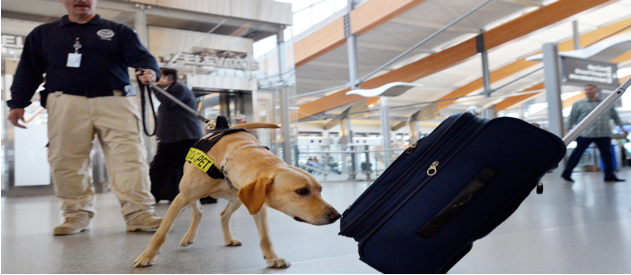CommentsSECURITY POLITICS-The reason Transportation Security Administration (TSA) security lines across the country have become excruciatingly long is because TSA is not opening and staffing all of its screening checkpoints.
The TSA has directed resources and personnel away from screening to non-screening functions including behavior detection officers (BDO), the Visible Intermodal Prevention and Response (VIPR) program and passenger screening canine teams.
In order to immediately reduce overall wait time for travelers, TSA must redeploy its non-screening resources-none of which have been proven effective and all of which cost exorbitant monies-and personnel back to the screening checkpoint so that all lanes are open and fully staffed ahead of the busy summer travel season.
"On a daily basis, only a handful of the screening checkpoints at a terminal are open while the remaining checkpoints are closed," said Marshall McClain, a canine police officer at LAX, President of the Los Angeles Airport Peace Officers Association and a co-founder of American Alliance of Airport Police Officers (AAAPO).
"Passengers will be shocked with empty checkpoints in lines that last over an hour and a half-causing missed planes and extreme frustration. They are wondering what the problem is. TSA has the ability to staff these closed checkpoints but they are diverting resources and personnel to things like BDO, VIPR and passenger screening canines -programs that have shown to not enhance security, waste taxpayer dollars and take away from the TSA's core function of screening.
"By opening and staffing all available screening checkpoints with non-screening BDO, VIPR and TSA canine personnel, wait lines could be significantly reduced. In order to fortify security at the screening area, the TSA should simply abide by the law that's already on the books that requires an airport police officer be stationed at the screening checkpoint but should provide added flexibility and allow the officer to be within 300 feet of the checkpoint and do away with the blanket waiver to the law that the TSA Administrator can issue."
Recent calls by those with a bully pulpit, but without the understanding of how the process works, assert that TSA's passenger-screening canines reduce wait times and improve security. As the on-the-ground law enforcement officers, many of whom are canine handlers, that patrol some of the country's busiest airports, AAAPO police officers have seen no evidence to support this claim-we have seen quite the opposite, as has the American public and Congress.
The stated purpose of TSA's passenger-screening canines, or vapor wake dogs, are to detect explosives but they have an extremely high rate of false-positives that result in secondary screening of these individuals which ultimately delays screening wait lines even further and requires the use of additional TSA resources. TSA's passenger screening canine teams do not have a high degree of detection accuracy and have never positively identified explosives on a traveler. They may look good but they are only a dog and pony show which jeopardizes safety. Furthermore, the dog's nose goes "blind" within half an hour.
When a TSA passenger-screening canine alerts to explosives on a passenger (which have all been false-positives to date), TSA protocol calls for that individual to continue through the crowded screening checkpoint so that TSA can conduct secondary screening. Logistically, allowing a person who is suspected of having explosive material on their body to continue through the screening area jeopardizes the safety of surrounding passengers, particularly as they are clogging up the lines and causing a chokehold with more people to potentially injure if they do indeed have explosives. More time is lost because secondary screening involves more TSA resources. It is a lose, lose, lose scenario.
"The argument has been made that TSA's passenger screening canines can allow passengers to go through the screening process with shoes, belts and coats," said Frank Conti, a canine police officer and First Vice President of the Port Authority Police Benevolent Association.
"However, this does NOTHING to improve security at airports since these TSA canines are consistently yielding false positives-this process is scary and only provides a false sense of security. Law enforcement canine teams, who have the underlying police training to immediately identify the level of a threat and respond accordingly-by isolating the suspect-and have the capability to mitigate the problem before it reaches a sterile area and/or plane, should instead be used to fortify screening at airports."
"There is no doubt that screening wait times will surge this summer and that responsibility lies firmly with TSA," said Paul Nunziato, President of the Port Authority Police Benevolent Association and co-founder of the AAAPO.
"Over the last several years, the TSA wasted billions of dollars and has done nothing to promote safety. The result has been that TSA has stopped focusing on its primary goal of screening and began programs such as BOD, VIPR and canines to 'spend all the money Congress gave them,' according to former TSA Administrator John Pistole.
“TSA should screen passengers and luggage and put their money and manpower into doing this to the best of their capabilities. They've taken their eye off the ball and we are seeing the consequences. Right now it's just an inconvenience-soon it could be a nightmare scenario where a real threat gets through to a plane-and no one wants that to happen.
“It is beyond clear to any traveler that all TSA needs to do is fully staff all screening lanes at terminals. This is absolutely something they can do if they take their canine team, BDO and VIPR people and put them at the checkpoint-yes, it really is that simple."
(Jasmyne Cannick is a Los Angeles activist and writer and handles communications for LAAPOA.)
Explore
Our mission is to promote and facilitate civic engagement and neighborhood empowerment, and to hold area government and its politicians accountable.

 CityWatch Los Angeles
Politics. Perspective. Participation.
CityWatch Los Angeles
Politics. Perspective. Participation.
03
Thu, Apr















